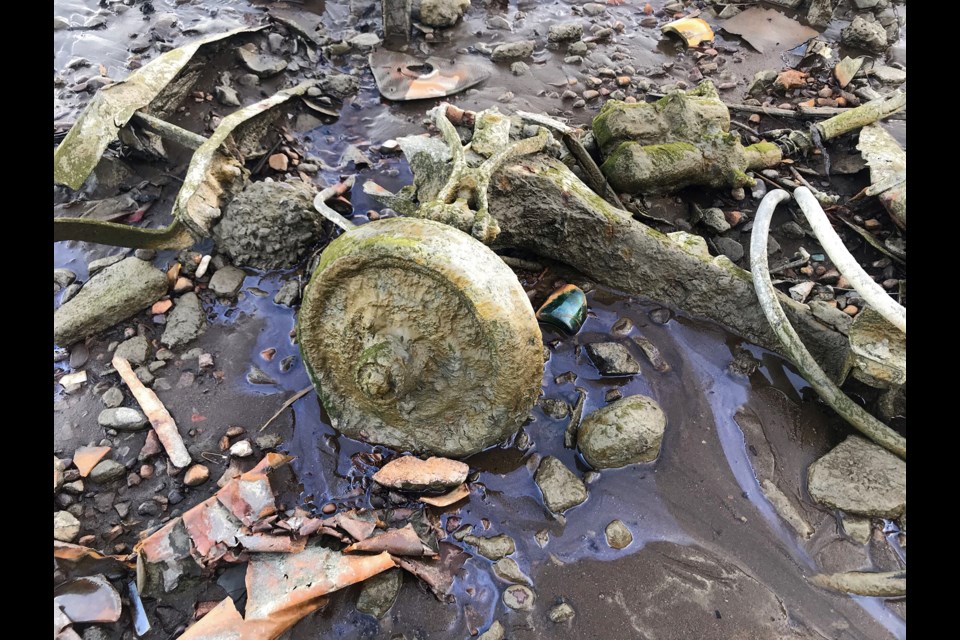There’s no sign of wildlife, no birdsong filling the air, along a rust-stained stretch of shoreline in east Richmond – creating an atmosphere that Steve LaRocca can only describe as “desolate.”
It’s incredibly rare, said LaRocca, to even see another person along the roughly 2.5-kilometre stretch, made up of two beaches known as “8 Ball” and “the Jungle” – separated by a waterway passable only at low tide – which lie to the east of Triangle Beach between No. 6 and No. 8 roads.
LaRocca, 50, began beachcombing in early 2018 after he found, by chance, a carved white horse figurine near No. 5 and Dyke roads. He frequently shares some of his finds and the art he’s created with them on social media under the handle FraserRiverFinds.
“You’re not going to find anything unless you get off the beaten path, and it was all just about wanting to see what’s around the corner,” he said.
The Richmond resident soon discovered 8 Ball and the Jungle. There, he’s found items dating back, most frequently, to around the 1960s, although some are a few decades older – including a British Columbia Automobile Association emblem that LaRocca estimates is likely from the 1920s or 1930s, and a lead horse and rider, one of his favourite finds.
But LaRocca – who also spends time cleaning up some of the places he visits around Richmond – is now hoping to draw attention to the state of the area, which was apparently the site of a dump through the mid-century, and why there are so many items to be found there.
“It’s an old dumpsite that’s been covered and is being exposed by tidal action. It’s insane… There’s never anything really modern there,” he said. “But another really important part about it is there’s no wildlife, which is really disgusting... You’d think it should be teeming with wildlife.”
He said it took him time to realize the full extent of the area – and the decrepit state it’s in.
“You just kind of find things and carry on… It’s not an area I’m out in all the time.”
The beach, LaRocca said, is tarnished an “ugly, ghoulish kind of orange colour” – stained by decades of decomposing metals and garbage – and puddles of oil released from gear boxes and motors are splattered across the shoreline. Old tires and decayed, rusted cars emerge from the sand along the Jungle, and in 8 Ball an exposed wall of trash bags appears to have become almost stratified.
He doesn’t know how far back that wall of plastic extends into the landscape. Some, he said, looks just as good as the day it was dumped there.
In the summer, 8 Ball “stinks” from the smell of oil and other items cooking in the sun. You have to wonder, LaRocca said, what’s hiding still.
“At some point, it’s just too much, because that little stretch of 8 Ball… I’ll find a pile of stuff one day, and I can go back there tomorrow and find a different pile of stuff, because it keeps getting exposed by tidal action,” he said.
“I’ve been making art pieces out of some of the (items), but it actually starts feeling a bit exploitive, to tell you the honest truth. Somebody’s got to do something about this.”
Coun. Harold Steves said he would like to see the City of Richmond investigate the area.
But Steves’ knowledge of the former dump site, pre-dating his years on Richmond council, is limited.
“I had no idea there was garbage outside the dike,” he told the Richmond News. “It was supposed to be quite a ways inland…So there shouldn’t have been water near it at all. It will take some investigation to find out who caused it…Either they didn’t get it cleaned up, or whatever they did to contain it has broken open.”
Steves said the dump site was traded to the federal government so they could have a port there, in exchange for the Richmond Nature Park lands, around the mid-1960s. The dump was shut down sometime later, but Steves said he wasn’t sure exactly when.
However, a spokesperson for the Port of Vancouver said the area appears to fall under the city’s jurisdiction.
The News reached out to the City of Richmond for more information, but did not receive a response by deadline.
Steves said there was once a similar site at the foot of 7th Avenue in Steveston – dating from the 1890s – which was contained when the city covered it with rip-rap, a method that could possibly be used at 8 Ball and the Jungle.
“There’s still a pile of ancient stuff under the dike, but the difference is, the 1890s didn’t have plastic. That plastic sticking out is terrible,” he said, adding the federal government may have to help clean up the site.
LaRocca also said some areas need to be properly cleaned up, and suggested that a weir system could be used to help lower the impact of waves and debris hitting the shore.



